| Author |
Message |
|
Risto Rautiainen
|
 Posted: Sun 18 Jun, 2006 6:33 am Post subject: 19th cent saber, identification help needed. Posted: Sun 18 Jun, 2006 6:33 am Post subject: 19th cent saber, identification help needed. |
 |
|
My relatives have a 19th cent supposedly russian saber that I'd like to get more information about. I've tried to look through the internet, but haven't found anything that resembles it. As it is quite light and short, I'd recon it's not for cavalry use. I'd also like to get more info about how should I proceed to preserve it best. First, some stats:
Total length: 88cm
Blade length: 73,5cm
Width of blade at the base: 3,5cm
Thickness of blade at the base: 6mm
Length of point ridge: 38cm
Pob: 8,5cm
Weight: 1080g
I went through some basic longsword drills with it as I don't know any saber stuff, and I have to say it certainly handles sweet. Controlling the tip was quite easy and as a whole the weapon felt natural in the hand. Then for the pics.
 Attachment: 94.68 KB Attachment: 94.68 KB

The most informative marking is this on the back of the blade, but I can only make the year "1864v"
 Attachment: 73.41 KB Attachment: 73.41 KB
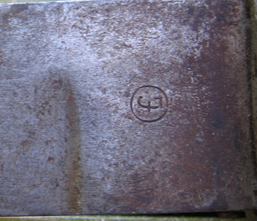
Blade marking at the base of the blade.
 Attachment: 49.99 KB Attachment: 49.99 KB
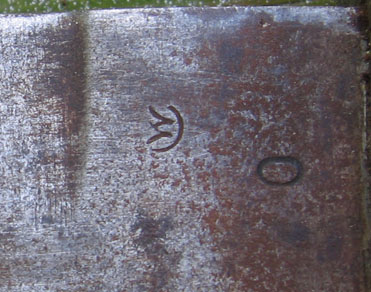
The same on the other side.
 Attachment: 100.86 KB Attachment: 100.86 KB
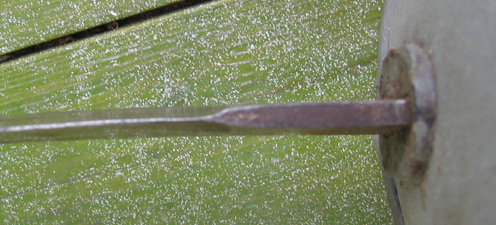
Edge at the base of the blade.
 Attachment: 85 KB Attachment: 85 KB
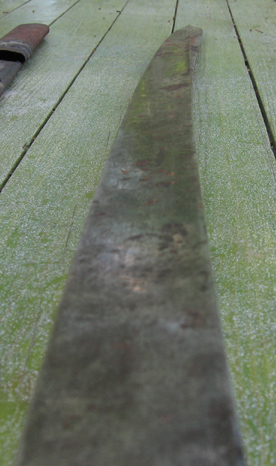
The blade.
 Attachment: 90.55 KB Attachment: 90.55 KB
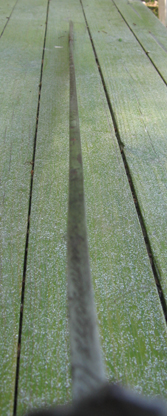
The back edge.
 Attachment: 109.51 KB Attachment: 109.51 KB
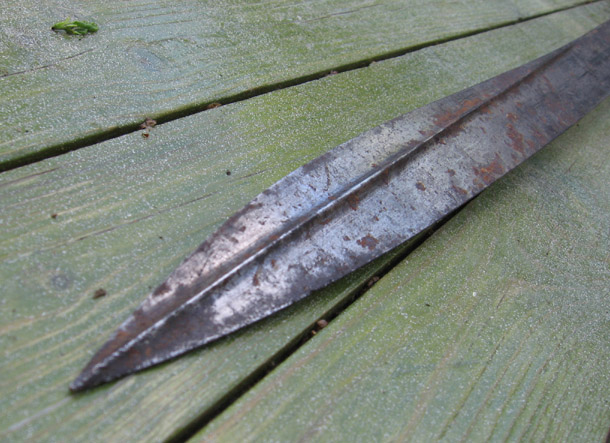
The tip reinforcement is about 5mm thick. The back edge here isn't very sharp at the time, but could have been sharpened.
 Attachment: 98.04 KB Attachment: 98.04 KB

The scabbard is in three pieces and has been tried to fix using some sort of fabric tape
Last edited by Risto Rautiainen on Sun 18 Jun, 2006 6:53 am; edited 1 time in total
|
|
  |
 |
|
Risto Rautiainen
|
 Posted: Sun 18 Jun, 2006 6:41 am Post subject: Posted: Sun 18 Jun, 2006 6:41 am Post subject: |
 |
|
Here's more pics.
 Attachment: 71.73 KB Attachment: 71.73 KB

The hilt has been painted afterwards.
 Attachment: 113.36 KB Attachment: 113.36 KB
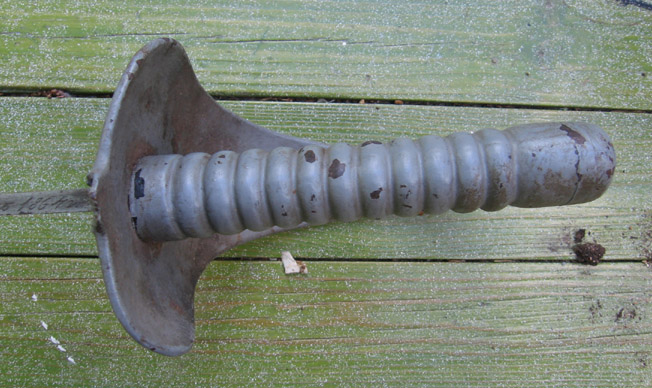
 Attachment: 123.21 KB Attachment: 123.21 KB
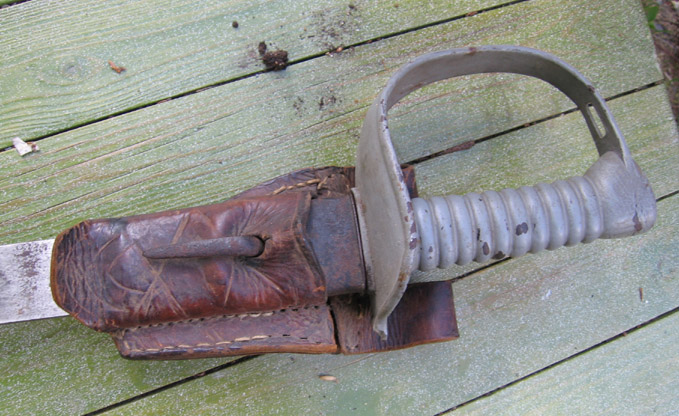
 Attachment: 108.99 KB Attachment: 108.99 KB
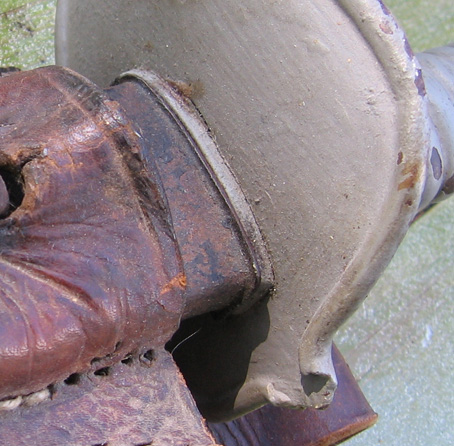
The sword fits the scabbard mouth perfectly. Here you can see that a piece has broken off the hilt.
 Attachment: 93.31 KB Attachment: 93.31 KB

The sewings of the leather of the scabbard are partly torn.
 Attachment: 100.15 KB Attachment: 100.15 KB
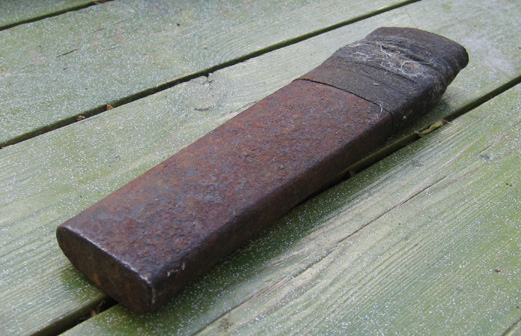
Chape seems to be made for the blade.
|
|
  |
 |
|
Risto Rautiainen
|
 Posted: Sun 18 Jun, 2006 6:50 am Post subject: Posted: Sun 18 Jun, 2006 6:50 am Post subject: |
 |
|
So do you know if this is a standard issue military blade and if it is, which military? How should I treat the blade especially the rusty spots? Just add Renessince wax? How about the hilt, should I remove the paint and if, then how? Should I remove the tape on the scabbard? How about renewing the sewing of the scabbard suspension? How should I treat the leather parts? What about the chape? Should I keep the blade in the scabbard of keep them separate? Here's the last pics.
 Attachment: 106.16 KB Attachment: 106.16 KB
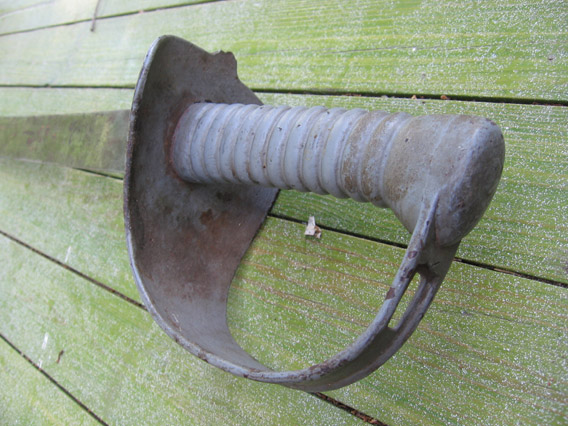
 Attachment: 103.11 KB Attachment: 103.11 KB
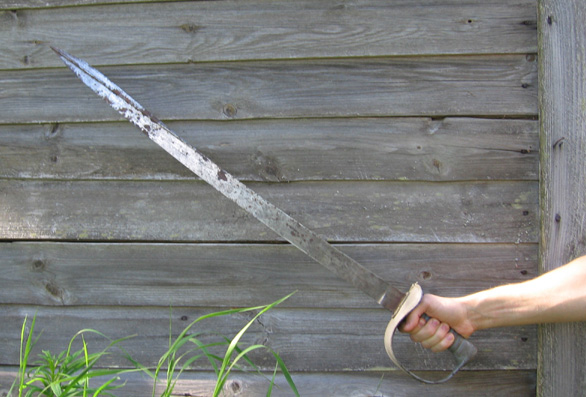
|
|
  |
 |
|
Jonathan Hopkins
|
 Posted: Sun 18 Jun, 2006 8:17 am Post subject: Posted: Sun 18 Jun, 2006 8:17 am Post subject: |
 |
|
Risto,
It looks like you have a Russian Model 1856 Naval Cutlass. It saw use until 1900. The blackened hilt was standard, so I would not recommend tampering with the paint (as it is probably original). The "quill point" blade was standard for this model.
As far as preservation/restoration, I personally tend to be more cautious and leave my antiques as untouched as possible. There are some great article on www.swordforum.com regarding the care of antique swords. Just do a search for restoration and/or preservation, or look through the threads on the Antique and Military Sword section.
Hope this was helpful!
Jonathan
PS--There are a number of people who regularly contribute at the Antiques and Military Sword section that could advise you regarding the scabbard, and any other more specific questions you have about preservation/restoration.
Edit: Now that I have taken another look at the paint on the hilt, it does not look original (is it grey?) Also, here is a thread that discusses restoration: http://forums.swordforum.com/showthread.php?s...estoration
and here is an article: http://swordforum.com/articles/ams/conservation.php
What the heck, here's one more: http://forums.swordforum.com/showthread.php?s...estoration
|
|
  |
 |
|
Dmitriy Sobolev
Location: Moscow, Russia Joined: 20 Apr 2006
Posts: 15
|
 Posted: Sun 18 Jun, 2006 9:48 am Post subject: Posted: Sun 18 Jun, 2006 9:48 am Post subject: |
 |
|
Marking on the blade reads as "Златоустъ" - the famous russian blade manufacture of Zlatoust. And the letter after the year is the written form of russian letter г for "год" - "year".
There are some photos of the piece. http://www.oldarms.ru/shpa.php?idg=1118
It has very characteristic leather scabbard, unlike most others bladed weapons of the period with steel scabbards.
In russian it is "Seaman's boarding pallash (broadsword? backsword?), pattern 1856". It seems strange for me too, because it has curved blade, and there were other russian naval weapons with curved blades, called sabers and half-sabers... But this one is "pallash".
|
|
   |
 |
|
Jonathan Hopkins
|
 Posted: Sun 18 Jun, 2006 10:26 am Post subject: Posted: Sun 18 Jun, 2006 10:26 am Post subject: |
 |
|
|
About the paint--while it might not be original, it might have been something that was added during the service life of the sword. It's hard to know.
|
|
  |
 |
|
Risto Rautiainen
|
 Posted: Sun 18 Jun, 2006 11:46 am Post subject: Posted: Sun 18 Jun, 2006 11:46 am Post subject: |
 |
|
|
Thanks for the fast replys! Haven't read the links yet, but will soon. The hilt is painted after the piece's service years.
|
|
  |
 |
|
Dmitriy Sobolev
Location: Moscow, Russia Joined: 20 Apr 2006
Posts: 15
|
 Posted: Sun 18 Jun, 2006 12:54 pm Post subject: Posted: Sun 18 Jun, 2006 12:54 pm Post subject: |
 |
|
Thank you, too - I never heard anything about weight and, of course, PoB of this sword before, so your stats was very useful.
(I have two very similar aluminium blunters, so now I'm very happy to know that their weights are realistic.  ) )
|
|
   |
 |
Arne Focke
Industry Professional

|
 Posted: Thu 22 Jun, 2006 2:26 am Post subject: Posted: Thu 22 Jun, 2006 2:26 am Post subject: |
 |
|
It looks like there might be some active rust towards the tip of the blade, which should be treated.
Simply apply, very carefully, some petroleum with a soft brush. That should take care of the rust and leave the original surface of the blade intact.
To conserve the blade you might use balistol.
So schön und inhaltsreich der Beruf eines Archäologen ist, so hart ist auch seine Arbeit, die keinen Achtstundentag kennt! (Wolfgang Kimmig in: Die Heuneburg an der oberen Donau, Stuttgart 1983)
|
|
   |
 |
|
Risto Rautiainen
|
 Posted: Tue 03 Jun, 2008 8:47 am Post subject: Posted: Tue 03 Jun, 2008 8:47 am Post subject: |
 |
|
I've finally finished conserving the sword. I removed the stitching on the sheath mouth to get it off the mouth piece. Then I waxed the leather and started working on the metal pieces of the sheath. It was hard to remove the rust without removing most of the original paint. Thats why some parts are still a bit reddish. I used nylon brushes and tooth brushes with CLP. Then I waxed the steel parts with renaissance wax. After that I sewed the sheath mouth together using waxed linen thread. I noticed that the leather around the steel sheath mouthpiece can't be original according to old sewing marks on the leather and this was confirmed by a photo I found of an original sheath.
Most of the work on the blade was done using a brass bristle and CLP. I had to use a brass pick to get the worst flakes of rust off the blade. There was a side effect to this as some of the brass got caught in the pitting and was quite hard to remove afterwards. For the hilt I used tooth brushes to keep the (not original) paint intact. Finally I treated the whole sword with Renaissance wax.
Then I made a display case for the sheath and the sword.
Well here's some before and after pics.
 Attachment: 52.92 KB Attachment: 52.92 KB
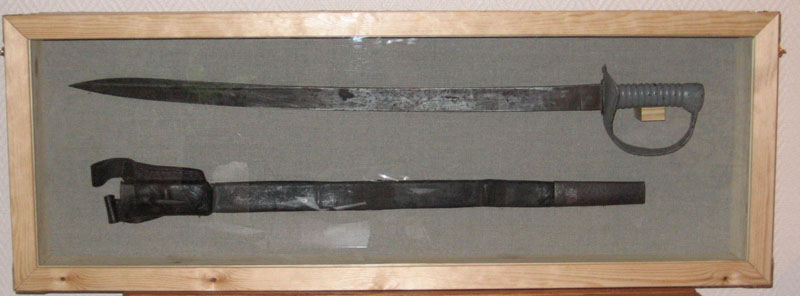
 Attachment: 62.18 KB Attachment: 62.18 KB
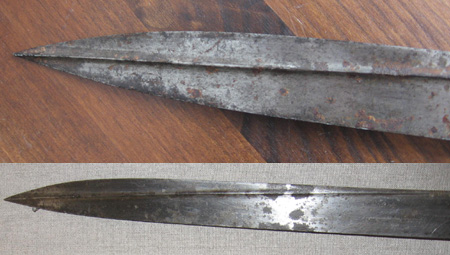
 Attachment: 144 KB Attachment: 144 KB
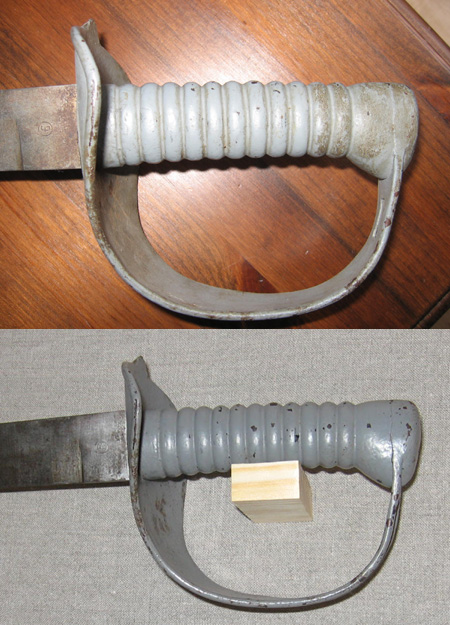
 Attachment: 119.2 KB Attachment: 119.2 KB

 Attachment: 131.98 KB Attachment: 131.98 KB
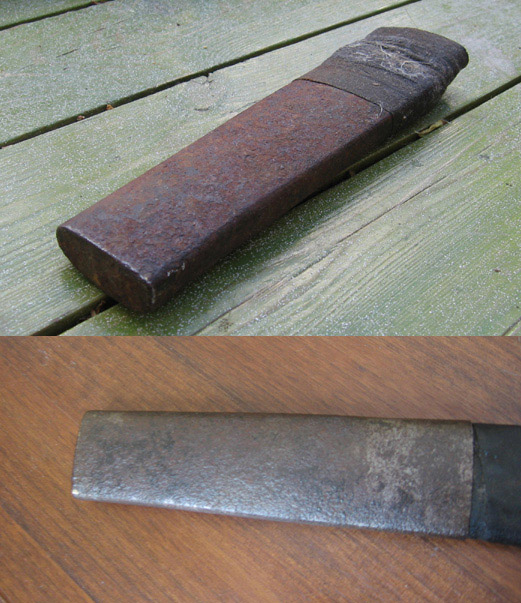
|
|
  |
 |
|
Jonathan Hopkins
|
 Posted: Tue 03 Jun, 2008 9:22 am Post subject: Posted: Tue 03 Jun, 2008 9:22 am Post subject: |
 |
|
Risto,
You've done an excellent job conserving the sword and displaying it! Do you plan to leave the paint on the hilt?
Jonathan
|
|
  |
 |
|
Risto Rautiainen
|
 Posted: Wed 04 Jun, 2008 12:49 am Post subject: Posted: Wed 04 Jun, 2008 12:49 am Post subject: |
 |
|
| Jonathan Hopkins wrote: | | You've done an excellent job conserving the sword and displaying it! Do you plan to leave the paint on the hilt? |
Thanks Jonatahan! I just followed the instructions on those links you provided, thanks for them! I'm going to leave the gray paint on as removing it would probably remove quite a lot of the original black underneath. This is also following one rule about antiques: they should be left as they are and only additional damage should be prevented.
|
|
  |
 |
|
|

